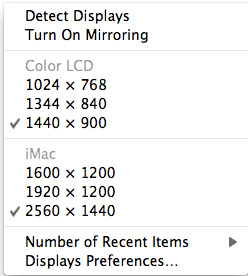Promise Pegasus R6 & Mac Thunderbolt Review
by Anand Lal Shimpi on July 8, 2011 2:01 AM ESTTarget Display Mode with an iMac
In our 2011 iMac review I mentioned that you could use the new iMac as an external display if, and only if, you had a Thunderbolt cable connecting it to a 2011 MacBook Pro. When I reviewed the iMac, you couldn't buy a Thunderbolt cable. Now you can.
The process is pretty simple. Just connect any 2011 MacBook Pro to any 2011 iMac via a Thunderbolt cable. Hit Cmd + F2 on the iMac's keyboard and boom, your brand new iMac is now a secondary display for your MacBook Pro. Note that you need a modern Apple keyboard for this to work. Older Apple keyboards and some non-Apple keyboards won't send the right key code and will refuse to activate target display mode on the iMac.
 |
 |
The iMac has to be fully powered on when this happens. You do lose all keyboard/mouse support on the iMac, however the machine doesn't go to sleep when in this mode - it'll remain on, although likely in a low power state. Any applications you have open on the iMac will remain open. Any music playing on the iMac will continue to play and you don't get use of the iMac's speakers from your MacBook Pro.

15-inch MacBook Pro (2011) + 27-inch iMac (2011) running in Target Display Mode
For 2011, this is admittedly an odd usage model. I'm not sure how many people want to connect their brand new MacBook Pro to a brand new iMac and use the latter as just a display. Down the road I can see this being a good feature as it lets you upgrade to faster MacBook Pros and still use your iMac as a larger display if you'd like.

I would prefer it if the iMac allowed itself to boot into a minimal environment where only the display and necessary ICs were powered, leaving the CPU, GPU, hard drive and the rest of the system mostly powered down. I suspect Thunderbolt complicates this as the controller needs a number of components powered up before it'll function. Perhaps future versions of the iMac can find a way around this limitation however.










88 Comments
View All Comments
Spazweasel - Friday, July 8, 2011 - link
$50 too much for a cable? Psshh. Children these days don't remember $75-100 SCSI-3 and UltraSCSI cables. These things are expensive for good reason.You want the highest performance, you pay to play. That's always been the case.
tzhu07 - Friday, July 8, 2011 - link
The phrase, "you get what you pay for" is generally true as a rule of thumb, but in the computer and consumer electronics industry, that has for the most part been untrue.Case in point: The high price of Monster cables having no performance advantage over the same type of cables one can find on newegg at a much lower price.
Apple just has this technology cornered....for now.
tzhu07 - Friday, July 8, 2011 - link
Well, I should say untrue in the computer and consumer electronics cable market.darwinosx - Friday, July 8, 2011 - link
The technology is Intel's not Apples. Intel determines the licensing fees.Samus - Friday, July 8, 2011 - link
Yes, but like SCSI, Apple was its only mainstream delivery vehicle. Back in the 80's and 90's, SCSI interfaces were reserved for servers, ultra high end workstations, and Apple computers. They always push the bleeding edge, which is possibly the only thing I respect about Apple.Justin Case - Saturday, July 9, 2011 - link
This has nothing to do with "pushing the bleeding edge". This has to do with giving Apple an "excuse" to remove USB ports from their iToys, thus locking out 3rd party accessory manufacturers (Thunderbolt is far too expensive to be competitive, unless you have a special deal like Apple has with Intel).The Mac hasn't been Apple's main focus for a long time; it's all about iOS and its ecosystem, now.
haley2011 - Sunday, July 10, 2011 - link
okMySchizoBuddy - Sunday, July 10, 2011 - link
doesn't the article specifically say that thunderbolt is free to license.Isn't Promise Pegasus a 3rd part manufacturer. Do you have any source claiming that Promise has a special deal with Apple.
Sony has thunderbolt ports in it's laptop as well.
Focher - Sunday, July 10, 2011 - link
Besides that you give away your bias of anything from Apple, TB isn't an Apple technology. It's an Intel one. What I find ironic is the USB versus TB arguments. First, it's a false choice. Even Apple has offered both FireWire and USB ports for years on their machines. It's only recently that FireWire has started to be removed from models. There's no current indication that USB will be dropped by Apple. Second, in specific regards to USB 3.0 I don't see the argument versus TB device availability. Neither have much market penetration yet, so only time will tell how each of them will do - and both could do fine or both could fail.MobiusStrip - Tuesday, July 12, 2011 - link
iOS devices are toys, but they already lack USB ports. They don't have any proper developer- or user-accessible I/O, so you think Apple's going to put Thunderbolt ports on them?NO. Apple has created a whole line of mobile devices that are ironically isolated from the world around them.